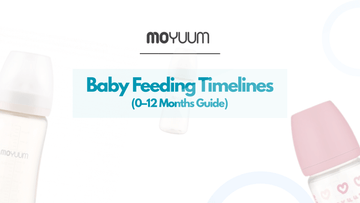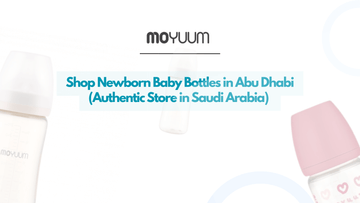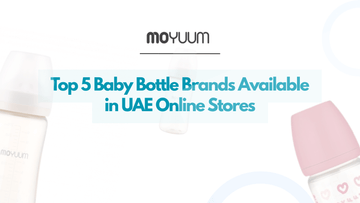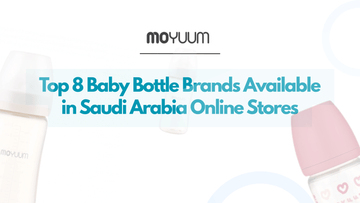Feeding your baby in the first year can be confusing. With so much advice out there, it’s hard to know what is right. A baby feeding timeline is a simple guide that shows what to feed your baby each month from birth to one year. It covers when to introduce breast milk, formula, purees, finger foods, and solids.
Feeding your baby based on their age supports healthy growth, proper nutrition, and safe eating habits. It also helps avoid common mistakes like starting solids too early or missing key milestones. Every baby is unique, but a clear timeline gives you a reliable starting point.
Use this guide to feel more confident about what and how to feed your baby throughout their first year.
Baby Feeding Timeline: Month-by-Month Breakdown
0 to 4 Months: Breast Milk or Formula Only
At this stage, your baby should receive only breast milk or infant formula. These provide complete nutrition for healthy growth and development.
Do not introduce solids, water, or juice. Your baby's digestive system is not ready for anything beyond milk.
Feed your baby every 2 to 3 hours, including during the night. Newborns may feed 8 to 12 times in 24 hours.
Look for signs of healthy feeding such as frequent wet diapers, consistent weight gain, and a satisfied baby after feeding.
4 to 6 Months: Signs of Readiness and Introduction to Solids (With Pediatrician's Approval)
Some babies may show signs they are ready to begin solids during this period. Common signs include good head control, the ability to sit with support, and interest in food when others are eating.
Continue to offer breast milk or formula as the main source of nutrition. Solids are only for practice and exposure at this age.
If approved by your pediatrician, start with thin, iron-rich purees such as iron-fortified rice cereal, pureed vegetables, or fruits.
Introduce one new food at a time, waiting 3 to 5 days before adding another. This helps identify any allergies or reactions.
Avoid honey, cow’s milk, salt, and added sugar, as these are not safe or suitable for babies at this stage.
6 to 8 Months: Solids Become Part of the Daily Routine
Breast milk or formula should still be your baby’s main source of nutrition, but solids now become a regular part of the day.
Start with 1 to 2 small meals of solids. These can include mashed fruits, soft-cooked vegetables, soft cereals, and pureed meats.
You can begin to introduce allergenic foods like peanut butter or egg yolk in small amounts if your pediatrician agrees.
Be cautious about choking hazards. Avoid foods like whole grapes, raw veggies, and hard chunks that are difficult to chew.
8 to 10 Months: More Texture and Self-Feeding Begins
Your baby is ready to explore new textures and start practicing self-feeding.
Add soft finger foods such as banana slices, scrambled eggs, soft pasta, and small pieces of bread.
Increase to 2 to 3 solid meals per day, and you may add snacks like soft fruit or baby-safe crackers.
Encourage your baby to use their hands or a baby spoon to feed themselves, even if it gets messy.
Continue offering 24 to 32 ounces of breast milk or formula per day, and start giving small sips of water from a cup.
10 to 12 Months: Transitioning to Family Foods
Your baby is now ready to eat most of the same foods you eat, in safe and manageable forms.
Offer 3 solid meals and 1 to 2 snacks daily. Begin to gradually reduce breast milk or formula as your baby’s solid intake increases.
Serve chopped and well-cooked versions of family foods, focusing on iron-rich and protein-packed options like meat, beans, and lentils.
Avoid whole nuts, popcorn, sticky candies, and unpasteurized dairy as they are unsafe for babies.
Support your baby’s transition to family meals by offering a variety of textures and letting them explore new tastes.
How to Know If Your Baby Is Eating Enough (Without Overfeeding)
It’s natural to wonder if your baby is getting the right amount of food. You can monitor this through a few simple signs.
Track your baby’s weight gain during regular checkups. Steady growth is a good sign of proper nutrition.
Watch for diaper output. A well-fed baby will have several wet diapers and regular bowel movements each day.
Pay attention to your baby’s hunger and fullness cues. If your baby turns their head away, pushes food out, or becomes fussy, they may be full. Reaching for food or opening their mouth are signs of hunger.
If you’re unsure about feeding patterns or your baby’s growth, consult your pediatrician for guidance.
Safe Feeding Practices at All Stages
Safety matters at every stage of feeding. Here are some basic rules to follow:
-
Always supervise your baby while they are eating.
-
Never force-feed. Let your baby decide when they’ve had enough.
-
Use age-appropriate utensils that are soft, easy to hold, and safe for teething gums.
-
Watch for signs of allergic reactions, such as rashes, vomiting, or swelling after trying a new food.
-
Keep high-risk choking foods out of reach. This includes whole grapes, nuts, hard vegetables, popcorn, and sticky candies.
By following these simple steps, you can make feeding time safe, enjoyable, and stress-free.
What Foods to Avoid in the First Year (Must-Know List)
Your baby’s body is still growing and developing during the first year of life. Some foods are not safe for this stage and can cause serious health problems. As a parent or caregiver, you need to know what to avoid. Here is a clear list of foods that you should not give to your baby before their first birthday.
1. Do Not Give Honey to Your Baby
Honey is not safe for babies under 12 months of age. It can contain bacteria called Clostridium botulinum, which can cause infant botulism. This illness affects your baby’s nervous system and can be life-threatening. Even a small amount of honey in food or on a pacifier can be harmful.
2. Do Not Use Cow’s Milk as Your Baby’s Main Drink
Your baby should not drink cow’s milk as a replacement for breast milk or formula. Cow’s milk does not have the right balance of nutrients and can be hard for your baby to digest. You can add small amounts of cow’s milk in cooking after 6 months, but do not use it as the main drink until your baby turns one.
3. Avoid Adding Sugar, Salt, or Giving Processed Foods
Babies do not need added sugar or salt. Their kidneys cannot handle too much sodium, and sugar can lead to unhealthy habits later. You should avoid giving your baby foods like cookies, chips, deli meats, or sweetened cereals. These processed foods often contain unhealthy ingredients and offer little nutrition.
4. Do Not Offer Foods That Can Cause Choking
Babies under 12 months are at high risk of choking. You should not give your baby hard, round, or sticky foods that are difficult to chew. These include:
-
Whole nuts
-
Hard candy
-
Whole grapes or cherry tomatoes (unless cut into small pieces)
-
Raw carrots and hard vegetables (unless cooked until soft)
Always stay with your baby during feeding and offer soft, easy-to-swallow foods.
5. Avoid Raw or Undercooked Eggs and Meats
Raw or undercooked foods may carry harmful bacteria. You should only give your baby fully cooked eggs, poultry, and meat. The egg yolk and white must be firm. Meats should be soft and cut into tiny pieces to prevent choking and infection.
6. Do Not Give Unpasteurized Dairy or Juices
Unpasteurized products can contain harmful bacteria that may make your baby sick. You should only offer pasteurized dairy products like plain yogurt or soft cheese after 6 to 8 months. Avoid unpasteurized milk and juice completely during the first year.
Final Thoughts
Baby feeding timelines are helpful for guidance, but they’re not strict rules. Every baby grows at their own pace, and it’s completely normal for some to take longer with solids or show interest earlier than expected.
Always consult your pediatrician if you’re unsure about what to introduce or when. And above all, focus on building safe, balanced, and age-appropriate feeding habits instead of trying to follow a perfect schedule.
Looking for baby essentials? Don’t miss our full range of feeding and care products including RealFit Nipples, baby pacifiers, teethers, straw cups, suction plates, suction bowls, and brush sets—all designed with your baby's safety and comfort in mind.





